Monday, December 22, 2008
A Birthday Celebration: Tropical Fruits & Vegetables
Fruits and vegetables! They are what our doctors recommend we include in our daily diets to ensure our health. As baby boomers age, more and more people are adding these wonderful gifts of nature to their diet. And with today being a reminder of that phenomenon in my own life, given that it is my birthday, I thought I would reproduce a [mildly edited] diary I had written about a year ago on the subject for the Daily Kos:
One of my greatest pleasures has become to plant, cultivate and consume my own fruits and vegetables. Everyone here in the tropics, where abundant rains ensure lush vegetation, has their own backyard fruit and vegetable garden. Even those (very rare souls) that don't, need only walk down a nearby street or park to harvest any of a number of fruits that grow on trees that have sprouted from discarded seeds throughout the years.
Here I will be sharing with you just a handful of fruits, spices and veggies which I have cultivated in my 'back yard' over the years. In the photo, you can see a sampling of a recent harvest.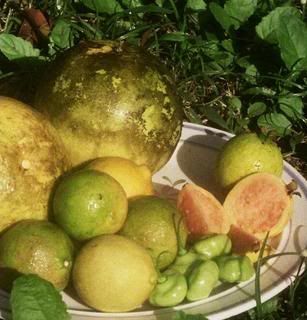
The large fruit in the upper left hand corner are grapefruit. Those are the last of my crop for this season. While mine have abundant seeds, they are unusually sweet. I have two trees and these were from the tree on the northern side of my house (the other is on the southern side). Next on the plate are five lemons from two trees I have right outside my kitchen. There is probably no fruit as essential to cooking as the lemon (I actually think they are limes but here in Puerto Rico we rarely call limes by their name). I use them for just about everything from cleaning meats to using as ingredients in marinades and dishes. Furthermore, I doubt you can imagine yourself eating fried fish without a lemon wedge nearby!
In front of the lemons, off to the right, are small sweet Spanish peppers (ajices dulces) which I guess would be classified as condiments or spices as opposed to vegetables or even fruit (although the ones in the photo I took are green, they can come in a variety of colors from bright red to a dark purple). They are not to be eaten raw but are very common in Latin American cooking from Puerto Rico to Venezuela. They are an essential ingredient in a traditional condiment that we prepare almost daily here in Puerto Rico: the ubiquitous Sofrito! It is a very versatile condiment which can be used to season meats, and as ingredients in rice and bean dishes, soups and seafoods. Use it to spice up any meal. Try seasoning your meatballs with it the next time you make spaghetti and meatballs! The following recipe makes about 4 cups:
Finally, on the far right of the plate you see a fruit which seen whole from afar would look just like a lemon. Once you cut it open, revealing its redish pink interior and numerous seeds (as pictured), you would be pleasantly surprised to discover it is actually a guava (guayaba in Spanish)! We had quite a guava orchard way back when my parents bought the property in the early sixties. Today, only two trees survive but I am replenishing the supply with young offshoots. My grandmother used to love to make a delicious guava stew when she was visiting in Puerto Rico to help my mother take care of me. Below is a photo of the ripe fruit on one of my trees.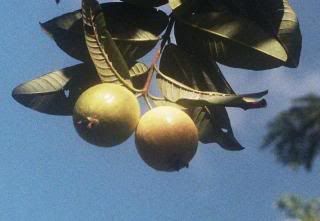 Half a cup of guava fruit has 4.5 grams of fiber, 188 mg of vitamin C, 344 mg of potassium, 26 retinol activity equivalents of vitamin A, 15 mg of calcium, and 40 mcg of folate. It is very easy to make a fabulous treat of guava preserves:
Half a cup of guava fruit has 4.5 grams of fiber, 188 mg of vitamin C, 344 mg of potassium, 26 retinol activity equivalents of vitamin A, 15 mg of calcium, and 40 mcg of folate. It is very easy to make a fabulous treat of guava preserves:
Next, I want to draw your attention to one of my favorite tropical fruits: the papaya. If any plant deserves the term "wonder plant" it is the papaya plant (it is technically not a tree). This tropical gem not only tastes heavenly on its own, but can be used in cooking and has medical and industrial applications as well. The plant in the photo is growing right up against the house and has over a dozen fruit on it (there is a better photo of the entire tree further on down in the diary). The bottom most fruit in the photo are ripe and (believe me) they tasted so good, I ate the entire fruit in one sitting! Interestingly, I didn't plant the papaya; it just grew there (possibly a kind bird or bat dropped the seed there and it took root and grew). Currently I have about six papaya plants growing around the house which I didn't plant either!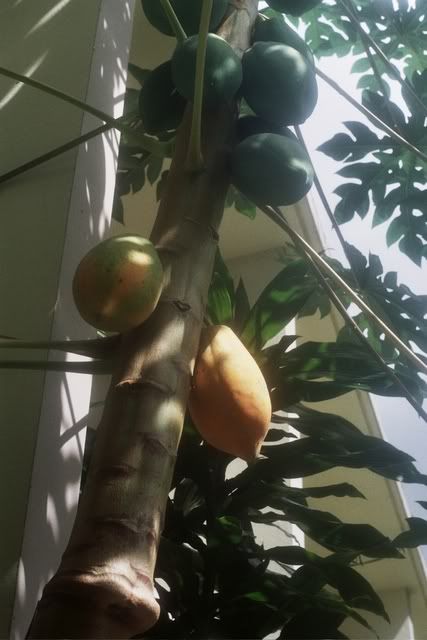
I could dedicate an entire diary to this wonder-fruit, so I'll just highlight a few of its uses and give you a recipe for a papaya salsa. From the Purdue University's Center for New Crops and Plants Products:
I really urge you to go to the Purdue site and read the entire piece on Papaya when you have a chance. For now, I want to pass on this (untested but delicious sounding) recipe which I pulled off the internet (I can't recall the site):
Moving right along... What backyard, no matter how modest, anywhere in the Caribbean would be complete without one or more banana plants? They are everywhere and while I do have various plants at my place, the photo below is actually of one of my plantain plants. The fruit are not ripe yet as the plantains have to fill out quite a bit more (doesn't the fruit bunch seem to resemble a strange creature from outer space with red lips?)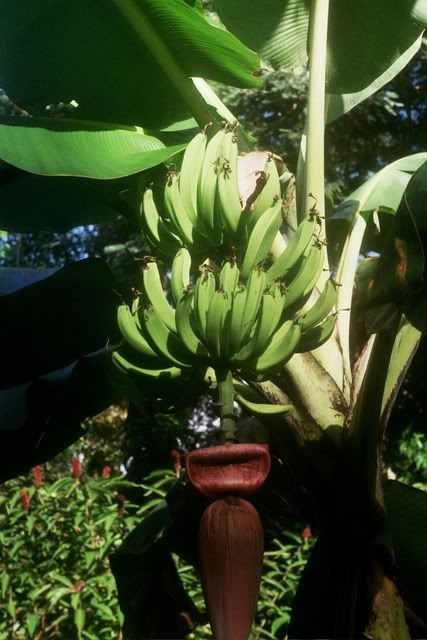
While similar in size and shape to the banana, the plantain fruit (not the herb!) cannot (or should not) be consumed without being cooked. Half a cup of plantain has 1.7 gm of fiber, 41 retinol activity equivalents of vitamin A, 14 mg of vitamin C, 369 mg of potassium and 16 mcg of folate. There are tons of recipes you can prepare with plantains, so I will just leave a link to (mostly) Puerto Rican recipes you can explore on your own.
Not too far from the papaya plant are two bushes of sweet basil. There are many types of basil. I have two varieties growing and while I can't name them, the one on the right is the most common and more aromatic of the two.
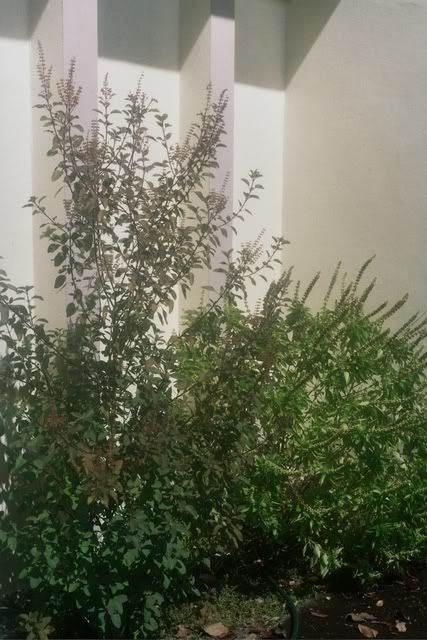
I am still learning the ins and outs of growing basil. I have been advised to not let the plants flower. By cutting off the flowers, it motivates them to produce more leaves. I'll remember that for next time!
Now, below is a more panoramic view of my papaya plant (sans the two ripe fruit pictured previously). I'm including this photo because in the foreground (to the left of the papaya plant) is a young avocado tree. It has yet to produce fruit but is coming along nicely. This scene is just outside my library (hence the airconditioner to keep the books from getting too humid). Once I get a harvest of mangos and avocados, I will be able to make that intriguing papaya salsa recipe (above).
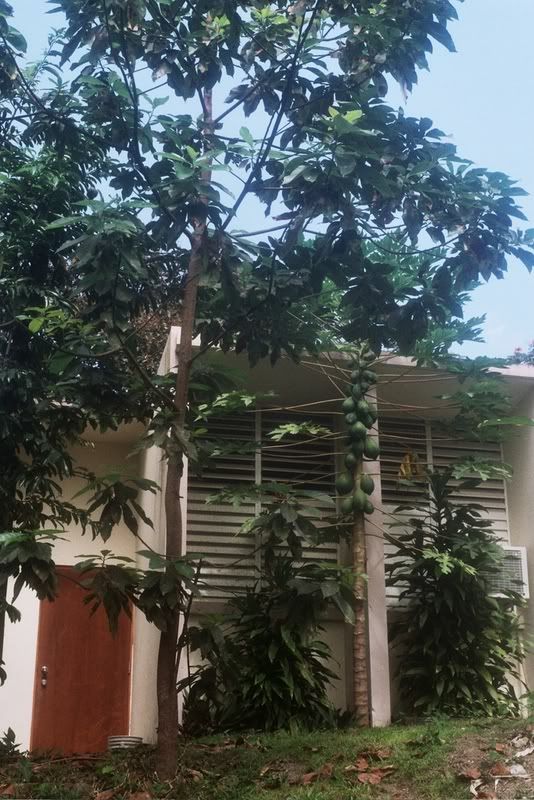
Even further to the left of the avocado tree (you can barely see some of the branches, since the tree itself is out of sight) is another wonderful tropical tree which produces another of my favorite fruits: the soursop, (Guanabana in Spanish)! Although called 'sour'sop, it is actually quite sweet and juicy. Below is a close-up photo of one of the fruits of that tree.
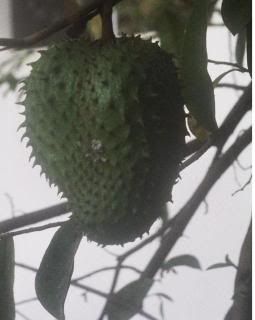
When ripe, the fruit has a fluffy white pulp which is excellent for making juice, sherbet or other treats. A half cup of soursop has 3.7 g of fiber, 23 mg of vitamin C, 16 mg of calcium, 313 mg of potassium, and 16 mcg of folate. Of particular medicinal use are the young leaves which are very effective in curing an upset stomach. The Purdue University Center for New Crops and Plants Products confirms what we in the Caribbean already knew:
The real treat, however, is a tall ice cold glass of soursop juice. Nothing beats it on a hot muggy day:
Just down an embankment from the soursop tree is one of several tannia or taro plants I have scattered around my property. Although sometimes called 'elephant ears' (see photo below), we call them yautia in Puerto Rico and tannia or dasheen in the Virgin Islands.
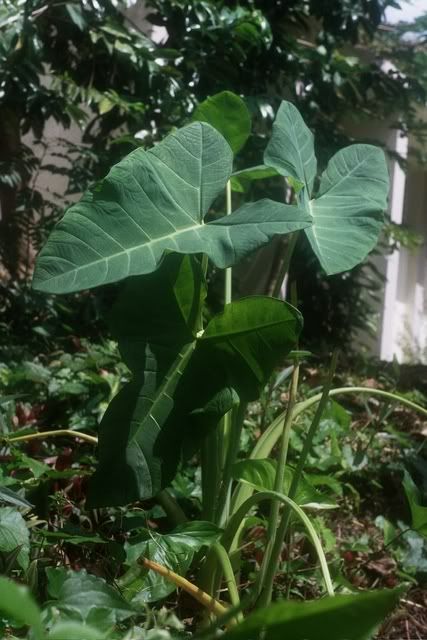
Although the leaves are rich in nutrients and are used, we tend to go for the tubers or corms that accumulate around the roots, eating them like potatos. Since they are not visible in the photo above, you can see what the tubers look like here. As Wikipedia tells us:
However, a warning for those of us that suffer from kidney stones:
For those of us that can stomach them, here is a wonderful recipe from the Virgin Islands:
The final item on my "list" is both a fruit and a condiment that I cherish, given my affinity for indian dishes. Almost two years ago I posted a comment on the Daily Kos about my tamarind tree. This year's (early 2008) tamarind crop is more plentiful than last year's and I have provided you a glimpse (below) at a small part of it.
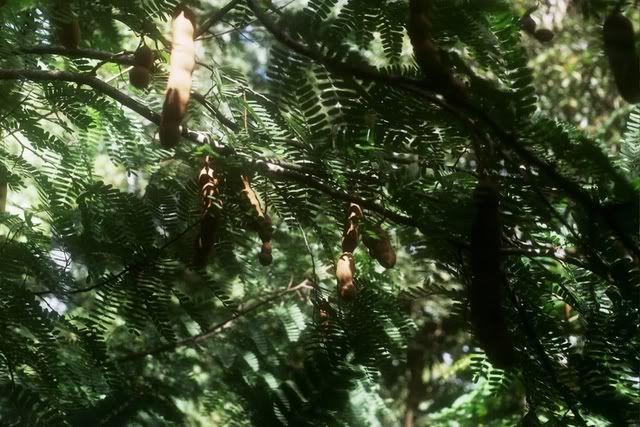
The tree itself is impressive and beautiful (unfortunately, I couldn't get a good photo of the entire tree to post for you here), as Purdue University's Center for New Crops and Plants Products tells us:
Aside from its use in dishes like Sambhar (which is what I'm having for dinner tonight), tamarind is made into a thirst-quenching tropical drink. As the CNCPP article goes on to note:
One slight correction to the above. We don't (to my knowledge) bottle it in carbonated form.
Fruits are abundant in nutrients, such as fiber, potassium, folate, and Vitamin C. Moreover, they also contain carotenoids and polyphenols, which act as antioxidants within the body. Eating large amounts of plant-based foods has been associated with lowered rates of cardiovascular disease (1, 2) and with decreased risk of cancer and stroke (2). Consuming adequate fruits and vegetables provides both essential nutrients and compounds that provide other beneficial physiological effects, not all of which are known.
One of my greatest pleasures has become to plant, cultivate and consume my own fruits and vegetables. Everyone here in the tropics, where abundant rains ensure lush vegetation, has their own backyard fruit and vegetable garden. Even those (very rare souls) that don't, need only walk down a nearby street or park to harvest any of a number of fruits that grow on trees that have sprouted from discarded seeds throughout the years.
Here I will be sharing with you just a handful of fruits, spices and veggies which I have cultivated in my 'back yard' over the years. In the photo, you can see a sampling of a recent harvest.

The large fruit in the upper left hand corner are grapefruit. Those are the last of my crop for this season. While mine have abundant seeds, they are unusually sweet. I have two trees and these were from the tree on the northern side of my house (the other is on the southern side). Next on the plate are five lemons from two trees I have right outside my kitchen. There is probably no fruit as essential to cooking as the lemon (I actually think they are limes but here in Puerto Rico we rarely call limes by their name). I use them for just about everything from cleaning meats to using as ingredients in marinades and dishes. Furthermore, I doubt you can imagine yourself eating fried fish without a lemon wedge nearby!
In front of the lemons, off to the right, are small sweet Spanish peppers (ajices dulces) which I guess would be classified as condiments or spices as opposed to vegetables or even fruit (although the ones in the photo I took are green, they can come in a variety of colors from bright red to a dark purple). They are not to be eaten raw but are very common in Latin American cooking from Puerto Rico to Venezuela. They are an essential ingredient in a traditional condiment that we prepare almost daily here in Puerto Rico: the ubiquitous Sofrito! It is a very versatile condiment which can be used to season meats, and as ingredients in rice and bean dishes, soups and seafoods. Use it to spice up any meal. Try seasoning your meatballs with it the next time you make spaghetti and meatballs! The following recipe makes about 4 cups:
SOFRITOAs a footnote, my late musician uncle, Neal Creque, composed a very popular tune entitled "Sofrito" (click to hear it!), which became the title piece of an album released by Cuban conga legend Mongo Santamaria.
2 medium Spanish onions, coarsely chopped
3 or 4 cubanelle peppers
15 - 20 garlic cloves
1 large bunch cilantro
7 - 10 Spanish sweet peppers
a couple of leaves of culantro (a much stronger version of cilantro)
3 to 4 ripe plum tomatoes, cut into chunks
1 large red bell pepper, seeded and coarsely chopped
Chop the onion and cubanelle peppers and place in a food processor. Process until coarsely chopped. Add the remaining ingredients one at a time and process until smooth. Your sofrito will keep in the refrigerator for up to 3 days, but it freezes well for longer keeping.
Finally, on the far right of the plate you see a fruit which seen whole from afar would look just like a lemon. Once you cut it open, revealing its redish pink interior and numerous seeds (as pictured), you would be pleasantly surprised to discover it is actually a guava (guayaba in Spanish)! We had quite a guava orchard way back when my parents bought the property in the early sixties. Today, only two trees survive but I am replenishing the supply with young offshoots. My grandmother used to love to make a delicious guava stew when she was visiting in Puerto Rico to help my mother take care of me. Below is a photo of the ripe fruit on one of my trees.
 Half a cup of guava fruit has 4.5 grams of fiber, 188 mg of vitamin C, 344 mg of potassium, 26 retinol activity equivalents of vitamin A, 15 mg of calcium, and 40 mcg of folate. It is very easy to make a fabulous treat of guava preserves:
Half a cup of guava fruit has 4.5 grams of fiber, 188 mg of vitamin C, 344 mg of potassium, 26 retinol activity equivalents of vitamin A, 15 mg of calcium, and 40 mcg of folate. It is very easy to make a fabulous treat of guava preserves:GUAVA PRESERVES
1 pound of guava
1 pound of sugar
1 cup of water
Pare guavas. Cut in halves; remove seeds. Boil sugar and water for 10 minutes. Add guava shells. Cook at low temperature until syrup is thick, not stiff.
Next, I want to draw your attention to one of my favorite tropical fruits: the papaya. If any plant deserves the term "wonder plant" it is the papaya plant (it is technically not a tree). This tropical gem not only tastes heavenly on its own, but can be used in cooking and has medical and industrial applications as well. The plant in the photo is growing right up against the house and has over a dozen fruit on it (there is a better photo of the entire tree further on down in the diary). The bottom most fruit in the photo are ripe and (believe me) they tasted so good, I ate the entire fruit in one sitting! Interestingly, I didn't plant the papaya; it just grew there (possibly a kind bird or bat dropped the seed there and it took root and grew). Currently I have about six papaya plants growing around the house which I didn't plant either!

I could dedicate an entire diary to this wonder-fruit, so I'll just highlight a few of its uses and give you a recipe for a papaya salsa. From the Purdue University's Center for New Crops and Plants Products:
Papaya is cultivated for its ripe fruits, favored by tropical people, as breakfast fruit, and as an ingredient in jellies, preserves, or cooked in various ways; juice makes a popular beverage; young leaves, shoots, and fruits cooked as a vegetable. Latex used to remove freckles. Bark used for making rope. Leaves used as a soap substitute, are supposed to remove stains. Flowers eaten in Java. Papain, the proteolytic enzyme, has a wealth of industrial uses. It has milk-clotting (rennet) and protein digesting properties. Active over a wide pH range, papain is useful in medicine, combatting dyspepsia and other digestive orders. In liquid preparations it has been used for reducing enlarged tonsils. Nearly 80% of American beer is treated with papain, which digests the precipitable protein fragments and then the beer remains clear on cooling. Papain is also used for degumming natural silk. But most of the papain imported in the U.S. is used for meat-tenderizers and chewing gums. Also used to extract the oil from tuna liver.
I really urge you to go to the Purdue site and read the entire piece on Papaya when you have a chance. For now, I want to pass on this (untested but delicious sounding) recipe which I pulled off the internet (I can't recall the site):
PAPAYA SALSA
1 mango peeled, seeded and chopped
1 papaya peeled, seeded and chopped
1 avocado peeled, pitted and chopped
½ sweet onion, peeled and chopped
2 Tbs Fresh Cilantro, chopped
1 Tbs Light Olive Oil
2 Tbs Balsamic Vinegar
Salt and pepper to taste
Cayenne pepper to taste
Brown Rice Syrup to sweeten if needed
Combine all the ingredients and chill for 30 minutes. Serve with tortilla chips.
Moving right along... What backyard, no matter how modest, anywhere in the Caribbean would be complete without one or more banana plants? They are everywhere and while I do have various plants at my place, the photo below is actually of one of my plantain plants. The fruit are not ripe yet as the plantains have to fill out quite a bit more (doesn't the fruit bunch seem to resemble a strange creature from outer space with red lips?)

While similar in size and shape to the banana, the plantain fruit (not the herb!) cannot (or should not) be consumed without being cooked. Half a cup of plantain has 1.7 gm of fiber, 41 retinol activity equivalents of vitamin A, 14 mg of vitamin C, 369 mg of potassium and 16 mcg of folate. There are tons of recipes you can prepare with plantains, so I will just leave a link to (mostly) Puerto Rican recipes you can explore on your own.
Not too far from the papaya plant are two bushes of sweet basil. There are many types of basil. I have two varieties growing and while I can't name them, the one on the right is the most common and more aromatic of the two.

I am still learning the ins and outs of growing basil. I have been advised to not let the plants flower. By cutting off the flowers, it motivates them to produce more leaves. I'll remember that for next time!
Now, below is a more panoramic view of my papaya plant (sans the two ripe fruit pictured previously). I'm including this photo because in the foreground (to the left of the papaya plant) is a young avocado tree. It has yet to produce fruit but is coming along nicely. This scene is just outside my library (hence the airconditioner to keep the books from getting too humid). Once I get a harvest of mangos and avocados, I will be able to make that intriguing papaya salsa recipe (above).

Even further to the left of the avocado tree (you can barely see some of the branches, since the tree itself is out of sight) is another wonderful tropical tree which produces another of my favorite fruits: the soursop, (Guanabana in Spanish)! Although called 'sour'sop, it is actually quite sweet and juicy. Below is a close-up photo of one of the fruits of that tree.

When ripe, the fruit has a fluffy white pulp which is excellent for making juice, sherbet or other treats. A half cup of soursop has 3.7 g of fiber, 23 mg of vitamin C, 16 mg of calcium, 313 mg of potassium, and 16 mcg of folate. Of particular medicinal use are the young leaves which are very effective in curing an upset stomach. The Purdue University Center for New Crops and Plants Products confirms what we in the Caribbean already knew:
...we are told to break soursop leaves in water, "squeeze a couple of limes therein, get a drunken man and rub his head well with the leaves and water and give him a little of the water to drink and he gets as sober as a judge in no time." This sobering or tranquilizing formula may not have been widely tested, but soursop leaves are regarded throughout the West Indies as having sedative or soporific properties. In the Netherlands Antilles, the leaves are put into one's pillowslip or strewn on the bed to promote a good night's sleep. An infusion of the leaves is commonly taken internally for the same purpose. It is taken as an analgesic and antispasmodic in Esmeraldas Province, Ecuador. In Africa, it is given to children with fever and they are also bathed lightly with it. A decoction of the young shoots or leaves is regarded in the West Indies as a remedy for gall bladder trouble, as well as coughs, catarrh, diarrhea, dysentery and indigestion; is said to "cool the blood," and to be able to stop vomiting and aid delivery in childbirth. The decoction is also employed in wet compresses on inflammations and swollen feet. The chewed leaves, mixed with saliva, are applied to incisions after surgery, causing proudflesh to disappear without leaving a scar. Mashed leaves are used as a poultice to alleviate eczema and other skin afflictions and rheumatism, and the sap of young leaves is put on skin eruptions.
The real treat, however, is a tall ice cold glass of soursop juice. Nothing beats it on a hot muggy day:
SOURSOP JUICE
1 soursop
1 quart of boiling water
Sugar to tastee
Remove the skin and core of one soursop. Over the pulp of the soursop pour boiling water. Let stand in covered container for half an hour. Strain and sweeten to taste.
Just down an embankment from the soursop tree is one of several tannia or taro plants I have scattered around my property. Although sometimes called 'elephant ears' (see photo below), we call them yautia in Puerto Rico and tannia or dasheen in the Virgin Islands.

Although the leaves are rich in nutrients and are used, we tend to go for the tubers or corms that accumulate around the roots, eating them like potatos. Since they are not visible in the photo above, you can see what the tubers look like here. As Wikipedia tells us:
Typical of leaf vegetables, taro leaves are rich in vitamins and minerals. They are a good source of thiamin, riboflavin, iron, phosphorus, and zinc, and a very good source of vitamin B6, vitamin C, niacin, potassium, copper, and manganese. Taro corms are very high in starch, and are a good source of dietary fiber.
However, a warning for those of us that suffer from kidney stones:
Oxalic acid may be present in the corm and especially in the leaf, and these foods should be eaten with milk or other foods rich in calcium so as to remove the risks posed by ingesting the oxalate ion, especially for people with kidney disorders, gout, or rheumatoid arthritis. Calcium reacts with the oxalate to form calcium oxalate which is very insoluble.
For those of us that can stomach them, here is a wonderful recipe from the Virgin Islands:
TANNIA SOUP
1/2 lb. salt fat meat, ham bones or ham
salt and pepper to taste
1 small onion
1 sprig of thyme
1 sprig of parsley
1 Tbsp. of margarine
5 large tannias
1/2 cup tomatos
Boil meat or hambones in two quarts of water; season with salt & pepper. Brown onion and seasonings in margarine; add to the water. Simmer for two hours. Add diced tannias and tomatos; cook gently until tannias are soft. Mash tannias and tomatos against the side of cooking pan. Serve garnished with chopped parsley.
The final item on my "list" is both a fruit and a condiment that I cherish, given my affinity for indian dishes. Almost two years ago I posted a comment on the Daily Kos about my tamarind tree. This year's (early 2008) tamarind crop is more plentiful than last year's and I have provided you a glimpse (below) at a small part of it.

The tree itself is impressive and beautiful (unfortunately, I couldn't get a good photo of the entire tree to post for you here), as Purdue University's Center for New Crops and Plants Products tells us:
The tamarind, a slow-growing, long-lived, massive tree reaches, under favorable conditions, a height of 80 or even 100 ft (24-30 m), and may attain a spread of 40 ft (12 m) and a trunk circumference of 25 ft (7.5 m). It is highly wind-resistant, with strong, supple branches, gracefully drooping at the ends, and has dark-gray, rough, fissured bark.
Aside from its use in dishes like Sambhar (which is what I'm having for dinner tonight), tamarind is made into a thirst-quenching tropical drink. As the CNCPP article goes on to note:
Tamarind ade has long been a popular drink in the Tropics and it is now bottled in carbonated form in Guatemala, Mexico, Puerto Rico and elsewhere. Formulas for the commercial production of spiced tamarind beverages have been developed by technologists in India. The simplest home method of preparing the ade is to shell the fruits, place 3 or 4 in a bottle of water, let stand for a short time, add a tablespoonful of sugar and shake vigorously. For a richer beverage, a quantity of shelled tamarinds may be covered with a hot sugar sirup and allowed to stand several days (with or without the addition of seasonings such as cloves, cinnamon, allspice, ginger, pepper or lime slices) and finally diluted as desired with ice water and strained.
One slight correction to the above. We don't (to my knowledge) bottle it in carbonated form.
Labels: Caribbean, crops, Food, fruits, tropics, vegetables


